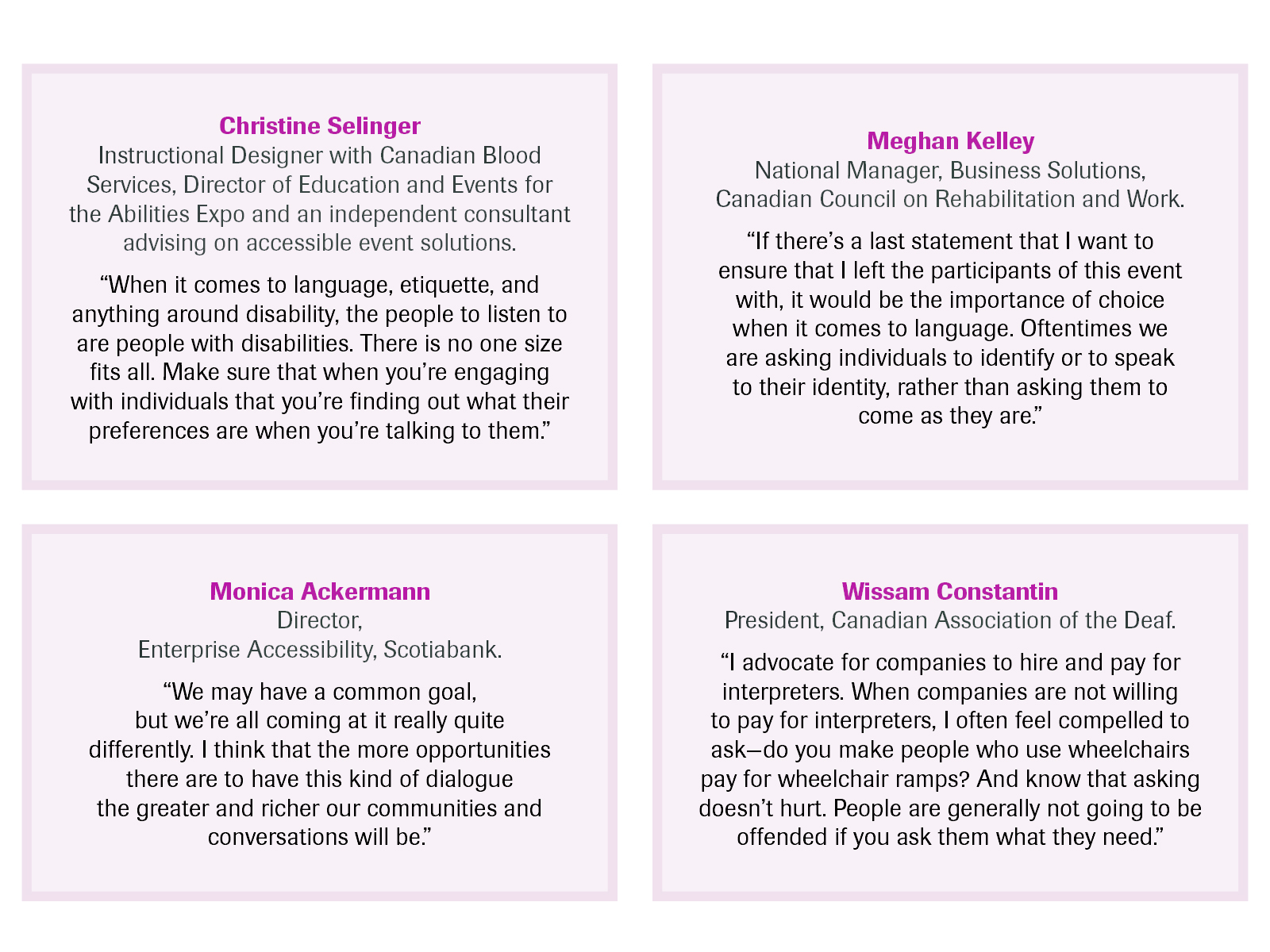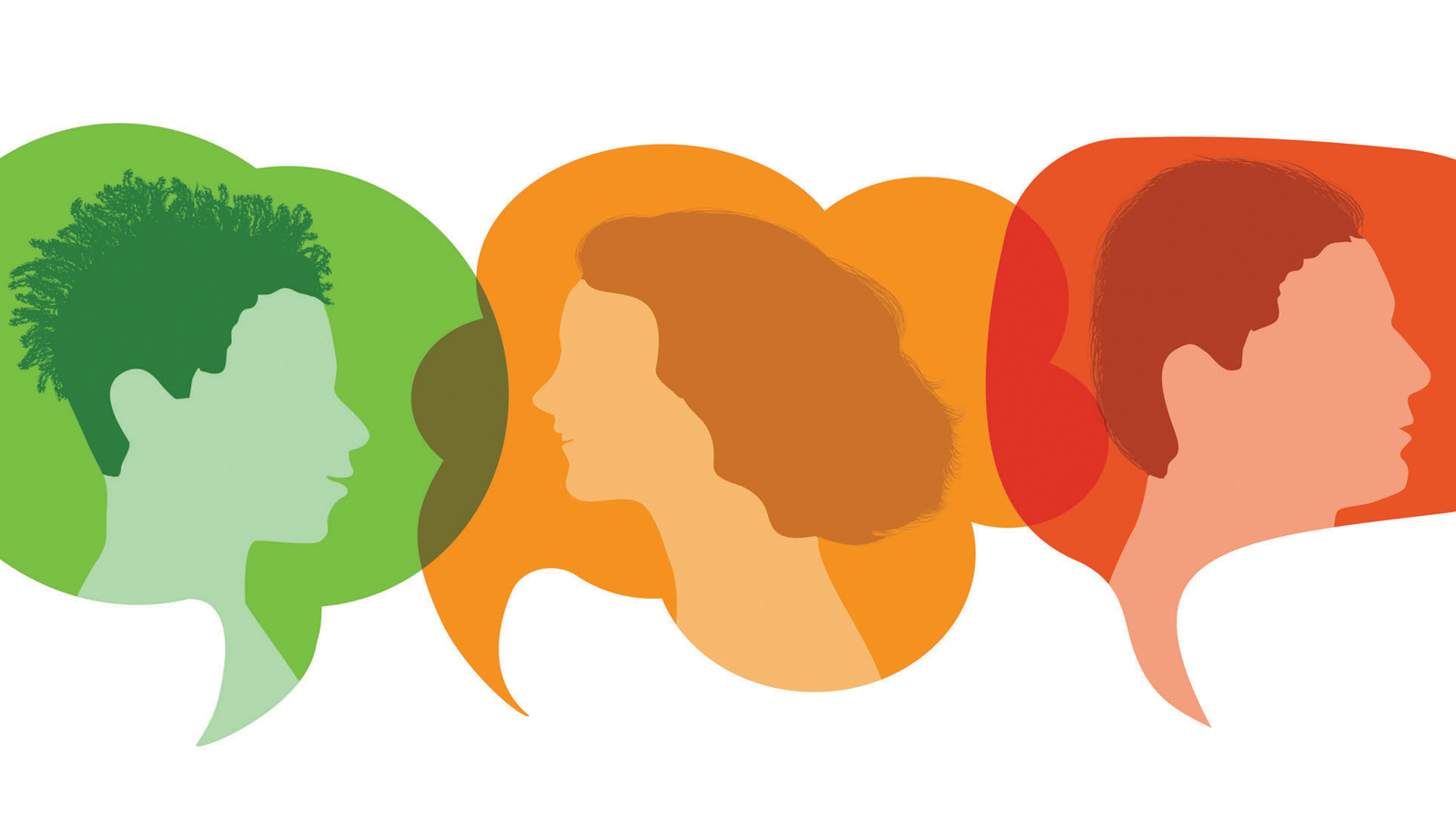By Rebecca Blissett
The words we use carry meaning and power. This was the theme of a live discussion held for International Day of Persons with Disabilities last December. The panel of accessibility and inclusion experts from across Canada offered plenty of food for thought during the hour-long conversation that was moderated by disability advocate Marco Pasqua. The following is a summary of the conversation.
The use of inclusive language comes down to being mindful. When we do our best to communicate thoughtfully, and with intention, we are promoting equity and advancing social progress for people with disabilities. However, inclusive language is not about simply using a list of “correct” words. “A list of words doesn’t change anything; attitude is what will make a difference,” suggests Wissam Constantin. “A person can say all the right words and still not have the right approach, the right tone, or the right attitude.”
The following questions sparked a thoughtful and engaging conversation:
Q) What does disability-inclusive language mean to you?
A) For Monica Ackermann, disability-inclusive language acknowledges that disability is about an individual’s lived experience and thus should be treated accordingly. It is also not about depicting people with disabilities as heroes to be admired or victims to be pitied.
“For me, disability-inclusive language is really about putting the person first; it’s being human-centered, and acknowledging that disability is an individual’s lived experience and an integral part of a person with the identity. Inclusive language really goes beyond the phrase used to describe a disability. Does the language perpetuate bias and stereotypes? Does it celebrate both the uniqueness and everydayness of the human experience? These, to me, are some of the inclusion decisions that we are empowered to make each and every day.”
Meghan Kelley added that inclusive language is ever-evolving, is nuanced, and reflects personal preference. “Language evolves over time, and the context and understanding of it that we have today will change as we learn and we grow. It’s about respecting the others around us.”
This also includes understanding the preference for person-first language, which puts an individual before their diagnosis, vs identity-first language, which is language that leads with a person’s disability, claims Christine Selinger. “I identify as a disabled person, specifically putting disabled first as I am a wheelchair user. To me, inclusive language across the board is both thoughtful and deliberate. I know language is difficult to change. Things will come out of your mouth before you realize what you’ve said—I’m definitely guilty of that! We’re not here today to tell you that what you’re doing is wrong or that you’re a bad person if you use certain language. We’re simply here to provide awareness of the impacts of language.”
Q) What are some of the communication considerations from a pan-disability lens?
A) “It’s essential to consider the whole population,” claims Christine. “When we’re thinking about language and disability, we need to think beyond mobility aids and beyond people who use wheelchairs. Disabilities aren’t segmented, so when thinking about one disability, you can’t just exclude others.”
Meghan highlighted the fact that communication methods have changed during the last 18 months with restrictions brought on by the pandemic. Virtual meetings have become the new normal for the office. She believes that the onus is on organizations and service providers to recognize gaps in accessibility and provide solutions within the digital realm.
Wissam made reference to the fact that disability-inclusive language is an individual preference, and stressed that there is a world of preference within a specific disability.
“I’ll use my disability, for example. Within the D/deaf culture, there’s a variety; people who prefer lip-reading, people who prefer signing, or reading and writing, and people who prefer to use an interpreter. If you have one experience with one disabled person, it doesn’t mean all disabled people are going to be similar.”
Q) Is there a time you experienced the impact of inclusive language?
A) Monica, who acknowledged she speaks as an ally, said she is heartened when she witnesses others make disability-inclusive language part of their vocabulary and work as it does a lot to contribute to a cultural shift. Christine used two examples to support this notion suggesting that she is used to organizations being caught off guard when she calls ahead of time to ask about their building’s accessibility. Recently, she called a pub where the employee rattled off a list of meaningful accessibility features. “I was totally unprepared for somebody else to be prepared for the question!” she said. “So, for anybody who runs a business, be prepared for the questions and have answers. It was so wonderful to recognize that this place was aware of the things that needed to be accessible.” She recalled another situation, at a funeral, where the officiant requested everybody to stand if they were able. “It was so tremendously impactful because it included me,” Selinger said. “There are lots of little ways to include disability in your everyday language.”
Q) How can we be advocates in our workplaces for inclusive language?
A) It’s vital that everybody—those with disabilities and those without—learn from one another. “I’ve heard it said that people with disabilities are not born to live; they’re born to advocate. I think that’s absolutely unfortunate, but true because we spend so much of our daily energy educating and explaining our needs,” claims Wissam. “People who have power in the workplace need to be cognizant of asking people with disabilities how they can be accommodated. It is also a necessity for a person with disabilities, when they encounter barriers, to speak up. I believe that working together, we’re able to make the world better.” The group agreed that employers can also lead by example by providing opportunities for dialogue and education.
It’s also important to be aware of ableist perspectives and how we frame conversations. “So often I’ll hear ‘the disabled employee is struggling to keep up with the productivity demands of the job.’ That’s a really ableist perspective. It’s not the disability that’s at the root of the struggle. If you want to call it that,” suggests Ackermann. “It’s the accessibility barriers in the workplace. In these conversations, too often I see and hear the words ‘issue,’ ‘problem,’ ‘concern’ in the same sentences as ‘disability.’ I don’t think it’s done maliciously or intentionally or to cause harm, but it is doing harm.”
As Constantin pointed out: “Disability itself is so often framed in the wrong way; it’s seen as what a person can’t do. And I would just like to say that we are just functioning in a different way. And that that’s all. It’s just a different perspective, a different way of being. No one way of being is better than another. It’s just a different way.”
Rebecca Blissett is the writer for the Rick Hansen Foundation. She is happy to be part of the movement to make Canada more accessible and inclusive.















